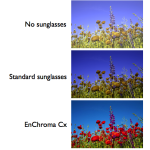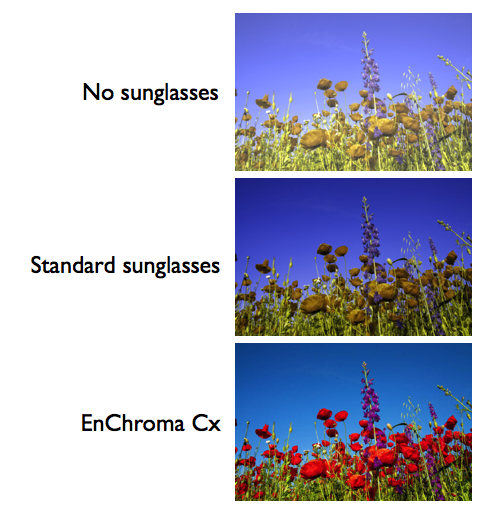
 Note: This post is part of the Color Conversations series. Each month, we will post an article pertaining to color. At the end of the month, we will hold a webinar related to the topic. The webinar will be held at noon CST on Tuesday, March 3. Click here to register.
Note: This post is part of the Color Conversations series. Each month, we will post an article pertaining to color. At the end of the month, we will hold a webinar related to the topic. The webinar will be held at noon CST on Tuesday, March 3. Click here to register.
Color blindness is a topic we’ve covered before, so it was with great interest that we read about the new technology EnChroma has developed to correct the condition. In essence, their Cx “glasses help color-blind see trees of green, red roses too.” The best part is that those who suffer from a red-green vision deficiency can buy a pair of these glasses today. But how do they work?
Light filters physically or mathematically
Going back about 20 years ago, there weren’t any spectrophotometers built for day-to-day use in the graphic arts industry. Those that were in use were referred to as bench instruments and were typically owned by ink companies for their centrally located matching labs. Instead, there were densitometers and colorimeters for color measurement on the shop floor. What these two instruments have in common are three physical glass or gelatin filters used to separate the visual spectrum of light (think rainbow) into three channels: red, green and blue.
These three filters are designed to mimic the way cones in the human eye see color. That’s because the three types of cones in the human eye are sensitive to red, green or blue light. In the case of a densitometer, the filters are manufactured in such a way as to be most sensitive to the cyan, magenta and yellow inks with which we print. This would allow press operators to measure a solid spot of ink and determine if they were putting enough ink down on the sheet of paper. On the other hand, colorimeters have filters chosen to see color more like the human eye would. The colorimetric filters also allow the measuring instruments to report color measurements in the now more popular tristimulus reporting formats such as X,Y,Z or L*a*b*.
These physical filters have limitations on the bands of light that they can capture. This is because they have to be made of out of naturally occurring or manufactured dyes and pigments. So to some extent, the accuracy of the instruments is determined by how accurately the filters capture only the bands of light they are supposed to without bleed over into other ranges of the visual spectrum. This is essentially the same situation cones within the human eye have. Normal cones have very little bleed over into other areas of the spectrum. That is to say that your red cones see mostly red and little or no green and blue. And your green cones only see green with little or no bleed over from red or blue. Finally, your blue cones only see blue with little or no bleed over from red or green.
When someone is said to be red-green color blind, it’s because their red and/or green cones have bleed over they should not from the other cones color bandwidths. A tristimulus instrument with this kind of bleed over would be said to be inaccurate. The filters in the tristimulus instrument age which makes them become color blind over time if they are not properly serviced and maintained.
Enter the age of the handheld spectrophotometer. While some spectrophotometers still work with filters, those filters are much more precise and narrow in the bandwidth they receive from the visual spectrum. Other spectrophotometers have done away with filters and instead split the light coming back with a prism and electronically capture only the wave lengths appropriate for proper measurement. This allows software to create mathematical or theoretical filters for whatever bandwidth or range of bandwidths necessary from the visual spectrum.
Basically these mathematical filters could also be called binary since they have no bleed over from unwanted bandwidths of the visual spectrum. And that is exactly what EnChroma has done with their Cx lens family. They have created binary narrow band tristimulus filters with no bleed over from other color families. This allows even those with red-green color deficiencies to finally see the vibrant reds and greens they’ve been missing their entire lives. By narrowing the bands of red and green light coming through the lens, they allow cones that otherwise get fooled by bandwidth bleed over to see color correctly.
Where we’ll go with the webinar
During the webinar on March 3, we’ll be sharing some informative yet fun websites that deal with color blindness which is really a misnomer for color vision deficiency. What I like about many of these sites is that they deal with the very same color theory necessary in the printing industry. So, we’ll review the content and exercises/tests on these sites with a focus on gaining a better understanding of color blindness and basic color theory at the same time.
Click here to view the Color Conversations webinar videos
[/pl_button][/pl_raw]